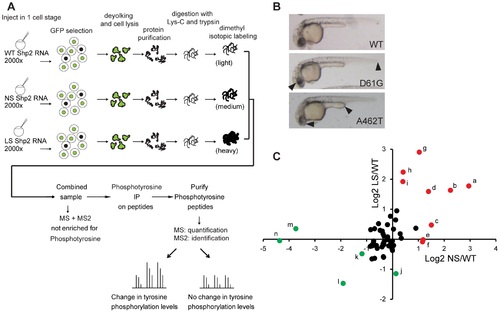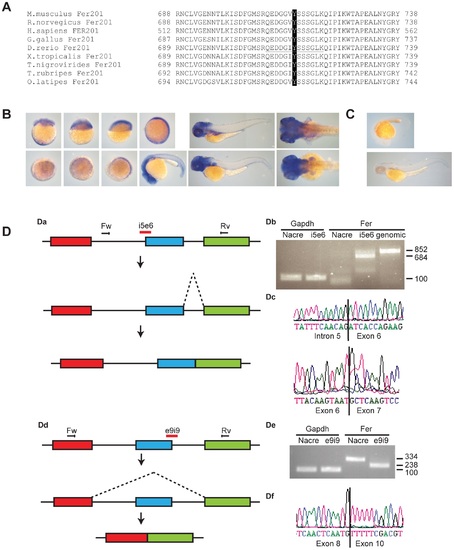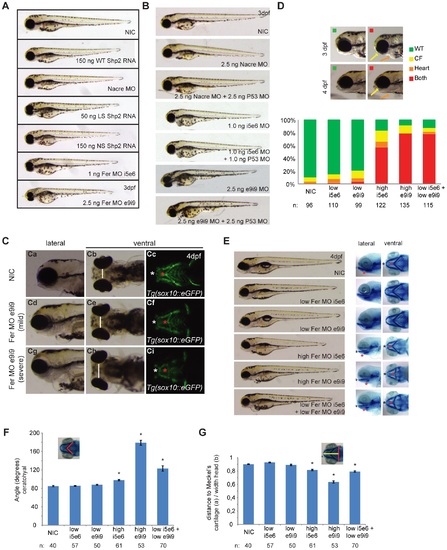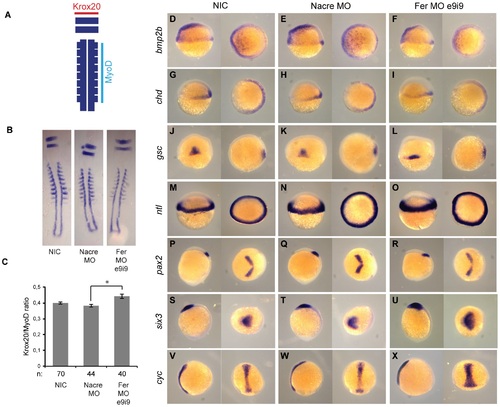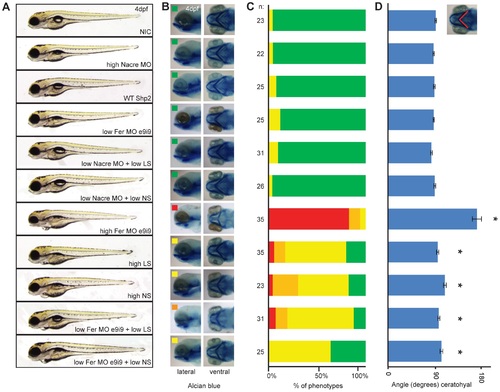- Title
-
Phosphoproteomics-Mediated Identification of Fer Kinase as a Target of Mutant Shp2 in Noonan and LEOPARD Syndrome
- Authors
- Paardekooper Overman, J., Preisinger, C., Prummel, K., Bonetti, M., Giansanti, P., Heck, A., Hertog, J.D.
- Source
- Full text @ PLoS One
|
Comparative pTyr mass spectrometry on 1 day old zebrafish embryos expressing wild type, NS (D61G) or LS (A462T) Shp2. A. Work flow depicting the mass spectrometry approach. Approximately 2000 zebrafish embryos per condition were injected at the 1-cell stage and sorted for GFP expression. Embryos were lysed, trypsinised and labeled using the dimethyl labeling method. WT, NS and LS samples were combined and immunoprecipitated using pTyr specific antibodies. Immunoprecipitate was subjected to MS and peptides were identified and quantified based on MS2 and MS1 spectra, respectively. B. 1 dpf zebrafish embryos expressing WT, D61G and A462T Shp2. Body axis length, craniofacial defects and heart edema in D61G and A462T Shp2 expressing zebrafish are indicated with arrowheads. C. Normalized plot of quantified phosphopeptides Log2 ratios. Peptide ratios with Log2 ratios >-1 and <1 are indicated in black. Peptides with more that 1× Log2 difference are annotated with a-n (see Table 1 for reference). Peptides changed with Log2 ratios <-1 in either NS or LS are indicated in green and Log2 ratios >1 in either NS or LS are indicated in red. See text for further details. |
|
Fer expression in zebrafish embryos and Fer MO induced splicing defects. A. Alignment of zebrafish Fer kinase sequence encompassing the autophosphorylation site (black) that was identified by phosphoproteomics with the mammals M. musculus, R. norvegicus, H. sapiens, the avian G. gallus, the amphibian Xenopus tropicalis, and the fish Tetraodon nigrovirides, Takifugu rupripes and Oryzias latipes. B. fer expression during the first 24 hpf and at 3 dpf and 4 dpf was observed using in situ hybridization with an antisense fer probe. C. ISH with negative control sense fer probe. D. RT-PCR showing altered splicing of fer in MO injected embryos. Da. Model of altered splicing by Fer MO i5e6. Exons 5, 6 and 7 are indicated in red, blue and green, respectively. Primers used for RT-PCR are indicated as arrows. MO is indicated in red. Due to splice blocking, intron 5 is not spliced out of the processed mRNA. Db. RT-PCR showing gapdh control in Nacre (control) MO and Fer MO injected embryos. RT-PCR showing Fer product in Nacre control MO and Fer i5e6 MO injected embryos, and genomic DNA as a positive control. Dc. Sanger sequencing showing the inclusion of intron 5 and the normal splicing of exon 6 in the RT-PCR product. Dd. Model of altered splicing by Fer MO e9i9. Exons 8, 9 and 10 are indicated in red, blue and green, respectively. Primers used for RT-PCR are indicated as arrows. MO is indicated in red. Due to defective splicing, exon 9 is spliced out of the processed mRNA. De. RT-PCR showing gapdh control in Nacre (control) MO and Fer e9i9 MO injected embryos. RT-PCR showing Fer product in Nacre control MO and Fer e9i9 MO injected embryos with a decrease in size of the product in e9i9 MO injected embryos. Df. Sanger sequencing showing the exclusion of exon 9. |
|
Fer knockdown induced craniofacial defects in zebrafish embryos.A. Embryos were injected at the 1-cell stage with 1 ng Fer i5e6 MO, 2.5 ng e9i9 MO or 2.5 ng Nacre MO as a negative control. Additionally, embryos were injected with 150 ng WT Shp2 RNA, 150 ng NS Shp2 RNA or 50 ng LS Shp2 RNA. B. Embryos were injected at the 1-cell stage with 2.5 ng Nacre control MO, 1.0 ng Fer i5e6 MO, 2.5 ng Fer e9i9 MO or in combination with 2.5 ng P53 MO. C. Craniofacial structures were imaged using Tg(-4.9sox10:EGFP)ba2 embryos expressing eGFP in neural crest cells that also form the cartilage. Embryos were injected with Fer MO e9i9 at the 1 cell stage and imaged at 4dpf. Ceratohyal is indicated with a red asterisk and Meckel′s cartilage with a white asterisk. Both moderate and severe phenotypes are depicted together with non-injected controls (NIC). D. Embryos were injected at the 1-cell stage with suboptimal concentrations of MO (0.5 ng i5e6 MO; n = 110 and 1.0 ng e9i9 MO; n = 99). High levels of both MO′s (1.0 ng i5e6 MO; n = 122 and 2.5 e9i9 MO; n = 135) or low levels of both MO′s were co-injected (n = 115). Embryos were imaged at 3 dpf and 4 dpf and grouped by having a WT appearance (green), a craniofacial defect alone (yellow) a heart defect alone (orange) or both (red) at 4 dpf. Relative levels of phenotypes are depicted. E. Embryos were injected at the 1-cell stage with normal dose of MO (1.0 ng i5e6 MO; n = 61 and 2.5 e9i9 MO; n = 53), low doses of MO (0.5 ng i5e6 MO; n = 57 and 1.0 ng e9i9 MO; n = 50) or a co-injected with low doses of MO (n = 70). Morphology at 4 dpf is depicted. Embryos were fixed and stained with Alcian blue at 4 dpf and imaged laterally and ventrally. For quantification, the angle of the ceratohyal (F) and the ratio of the distance from the back of the head to Meckel′s cartilage and the width of the head was determined (G) (* indicates significance, Student′s t-test p<0.005). EXPRESSION / LABELING:
PHENOTYPE:
|
|
Fer knockdown resulted in C&E defects but not in changes in cell fate. A. Krox20/myoD in situ hybridization as a method to quantify C&E defects. Krox20 (red) staining for rhombomeres 3 and 5 was used to measure the width, which correlates with convergence cell movements in the embryo. MyoD (light blue) staining for the somites was used to measure the length, i.e. extension of the embryo. The ratio of Krox20/myoD correlates directly with convergence & extension cell movements during gastrulation. B. Flatmounts of krox20/myoD stained NIC (n = 70), control MO (n = 44) and Fer MO (n = 40) embryos. C. The ratio of the width of a krox20-positive rhombomere and the length of 8 somites was determined (* indicates significance, Student′s t-test p<0.005). D-X. Embryos were injected at the 1-cell stage with control MO or Fer e9i9 MO and subjected to ISH for various markers of cell fate determination. Note that the staining of the gsc, pax2, six3 and cyc probes show broader and shorter expression in Fer knockdown embryos than in controls. PHENOTYPE:
|
|
Partial knockdown of Fer cooperated with suboptimal expression of NS- and LS- but not WT Shp2 to induce developmental defects. A. Embryos were injected with control MO, Fer e9i9 MO and NS, LS or WT Shp2 mRNA as indicated, and imaged at 4 dpf. B. Alcian blue staining showing craniofacial defects scored on severity (green: wild type, yellow: mild phenotype, orange: moderate phenotype, red: severe phenotype). C. Embryos were scored based on craniofacial defect upon alcian blue staining. The number of embryos per condition is indicated. D. The angle of the ceratohyal was quantified as a measure of craniofacial defects (* p<0.005, Student′s t-test). PHENOTYPE:
|
|
Attempted rescue of Fer MO and overexpression of Fer. Embryos were injected at the 1-cell stage with 2.5 ng Fer MO e9i9 either alone or in combination with increasing amounts of synthetic Fer mRNA (5 ng, 25 ng, 37.5 ng, 50 ng, 100 ng, 150 ng, 200 ng, 250 ng). Co-injection of Fer mRNA did not rescue the Fer knockdown phenotype. B. embryos were injected at the 1-cell stage with Fer WT mRNA. Injection of Fer mRNA by itself induced craniofacial defects, shorter length and heart edema. |

